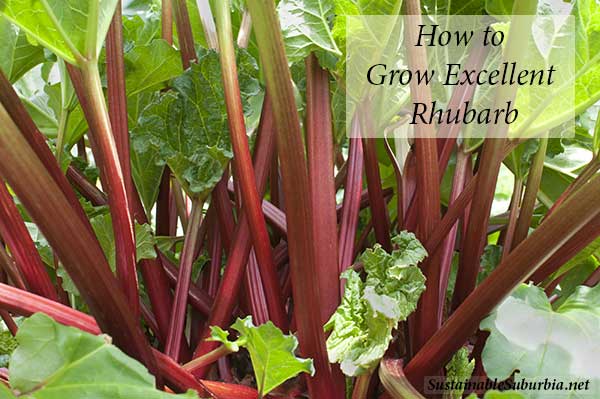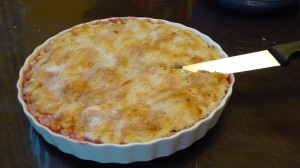
Although rhubarb looks like psychedelic celery, its striking bushy green foliage against its purple-red stems is a bright addition to the veggie patch or wherever you decide to plant it. Rhubarb is easy to grow and can be grown from crowns or seeds. By choosing crowns, which are a fleshy bundle of roots, you can be enjoying your rhubarb a year sooner.
Not unlike asparagus in many ways, Rhubarb was widely known for its medicinal properties, although it took a while for people to work out that its stems could be eaten and enjoyed. Curiously enough the leaves are a bit poisonous but luckily taste sour enough to be a deterrent. Besides you need to eat lots of leaves to get really sick. One good use for the leaves is to boil a quantity up in some water, add a little soap and then use as an insect spray.
Position and Locale

Rhubarb needs a cool/cold period to do well, coupled with a not too hot summer. It loves a full sun position, but will tolerate some shade and the hotter your summer is, the more protection it needs from the heat of the day. Soil must be free draining as it will not tolerate soggy conditions.
Planting
If you have a clay soil this will mean digging in plenty of compost at planting time. Another approach is to use a raised bed to ensure the best possible drainage. Still another option might be to use a half barrel or a big pot and use potting mix. It is a shame to wait a year in anticipation to find that the crown has rotted, so good drainage and plenty of compost is a must. Whatever method you decide on, the soil must be dug quite deeply and filled with good quality organic matter. Rhubarb prefers a slightly acid soil (pH 6-6.8) but will tolerate slightly more acidic conditions.
Weed well as it becomes harder once the crowns are established. Besides rhubarb likes to be left alone once established.
The crowns, which are available from nurseries, are best planted in early spring and planted about 10cm (4”) below the surface and from 60-80cm (2-3’) apart.
Growing
Growing rhubarb loves a good feed, so some well rotted manure each year will keep it growing lushly. This is best done in early spring. It is also good to cut early flowering stems to keep the plant focused on producing edible stems. As the plants mature, they may require thinning, which can be done ever y 3-4 years in winter when they are dormant. Rhubarb likes plenty of water while growing but don’t over water.
Harvesting
Two years have gone by and it’s time to enjoy! Gently pull the stems away from the crowns but don’t cut them. If the crowns are cut, this may open the way for fungal problems which can easily be avoided. Also, don’t be too hard on the plants and leave some stems to grow leaves which will feed next year’s crop. A rhubarb plant can give you around 15 years of production. You can also force the rhubarb by covering the crowns with large pots in winter. This makes it dark and can trick the plants into producing a harvest out of season.
You can aid an early crop by using a cloche which can be made from a cut clear PVC bottle in early spring. Make sure though that this is away from the plant by the time it gets hot or you run the risk of burning.
Varieties
Did you know that there is a green variety of Rhubarb as well as the more common red? There is a variety known as Victoria that is green and provides stems that taste as delicious as others. However for the dramatic effect and stunning colour re varieties such as Rheum x (various hybrids) and Glaskins are old favourites and easily obtained in Australia at least. There are 100’s of varieties and your local nursery can provide you with the best choices for your climate.
Companions
Companion planting is a great concept whereby plants can provide natural deterrents to pests or just simply like the company of other species. Rhubarb seems to like all other plants and does not need any other plants to do well, but it can buddy up with broccoli and cabbage to benefit those crops. Personally I think its beautiful colour is best enjoyed by a specific planting of rhubarb, but it’s up to you.
Enjoying
 Rhubarb goes well with apple and even better in a pie. Because it is quite tart it needs sweetening up, but, oh the flavour! Not only is it a great source of vitamin C, it is packed full of fibre, and served with a dollop or two of cream that has to be a winning combination.
Rhubarb goes well with apple and even better in a pie. Because it is quite tart it needs sweetening up, but, oh the flavour! Not only is it a great source of vitamin C, it is packed full of fibre, and served with a dollop or two of cream that has to be a winning combination.
Editor’s note: See the recipe for the rhubarb pie pictured. It’s truly delicious! Or see this post on how to cook rhubarb, for some stewed rhubarb to have on your breakfast cereal, or better yet with ice cream. Yum.
David Bay is a part time freelance writer living in Perth, Western Australia.


I have had wonderful results with two-year-old crowns planted in pots in October 2013 into this http://themicrogardener.com/easy-diy-potting-mix-recipe/ . I already have enough large stalks to be able to ‘sample’ a couple without harming the plant.
That’s great Elyssa. I must say I do love my Rhubarb, the way it just keeps on going year after year
How do you grow passion fruit successfully in perth backyard
I planted my rhubarb from a start last year. It is coming up now and one stalk already went to seed. How do I cut it back and should I?
Yes, the stalk needs to be removed to shift growing nutrients back to the edible stalks. Cut it back with secateurs as close to the soil as you can get. I have read that when rhubarb goes to seed, it means it either needs more food or more water.